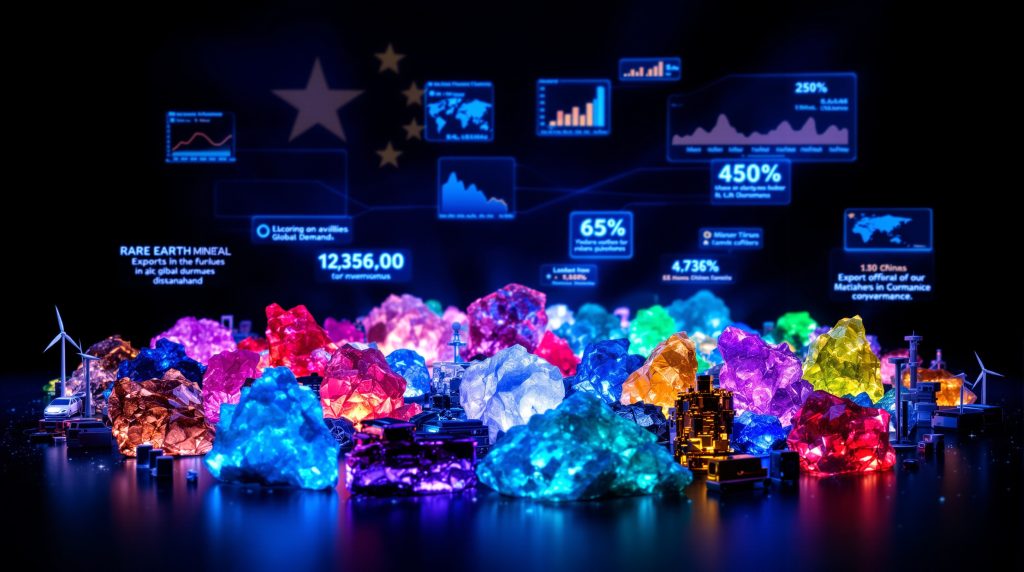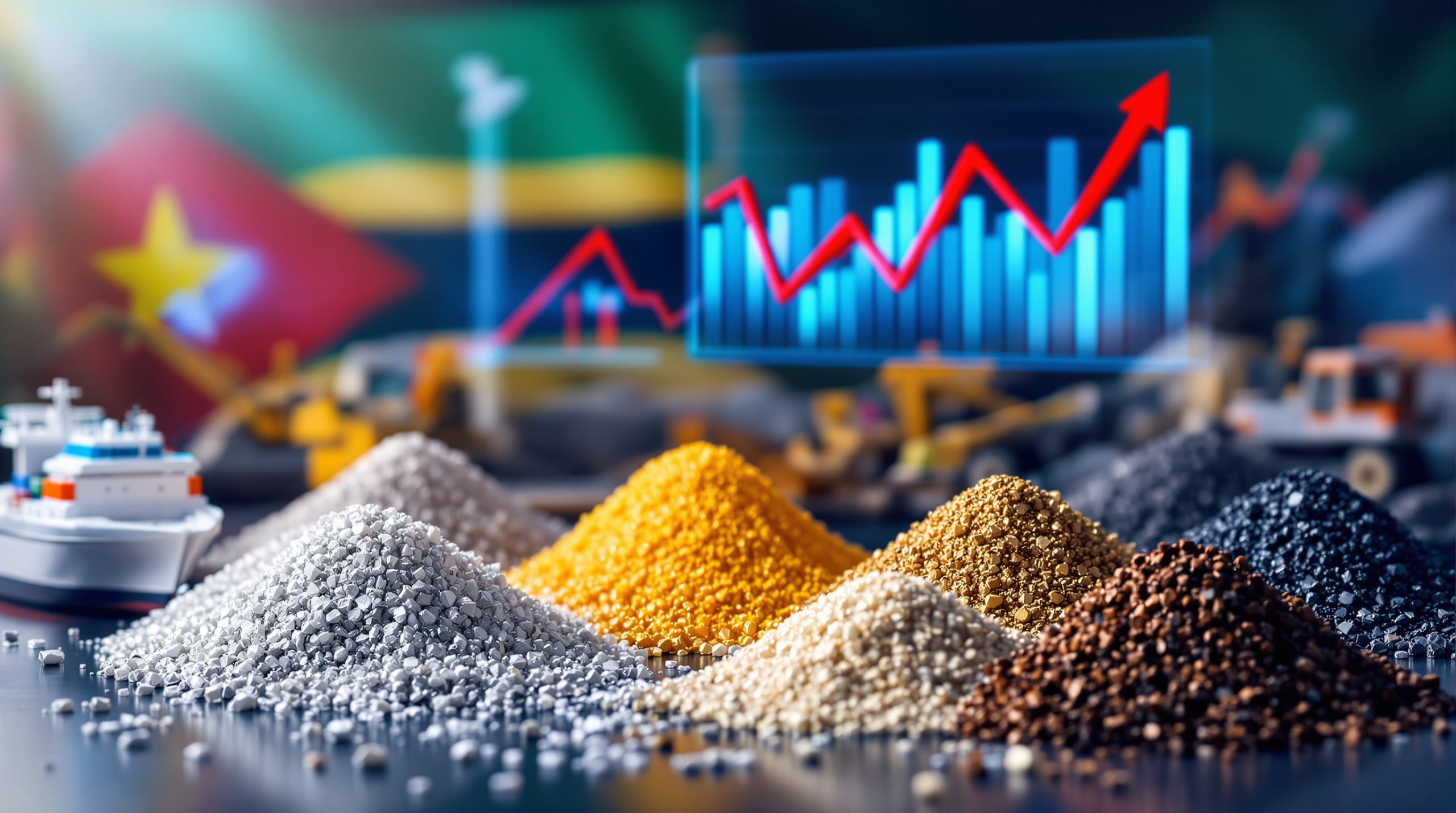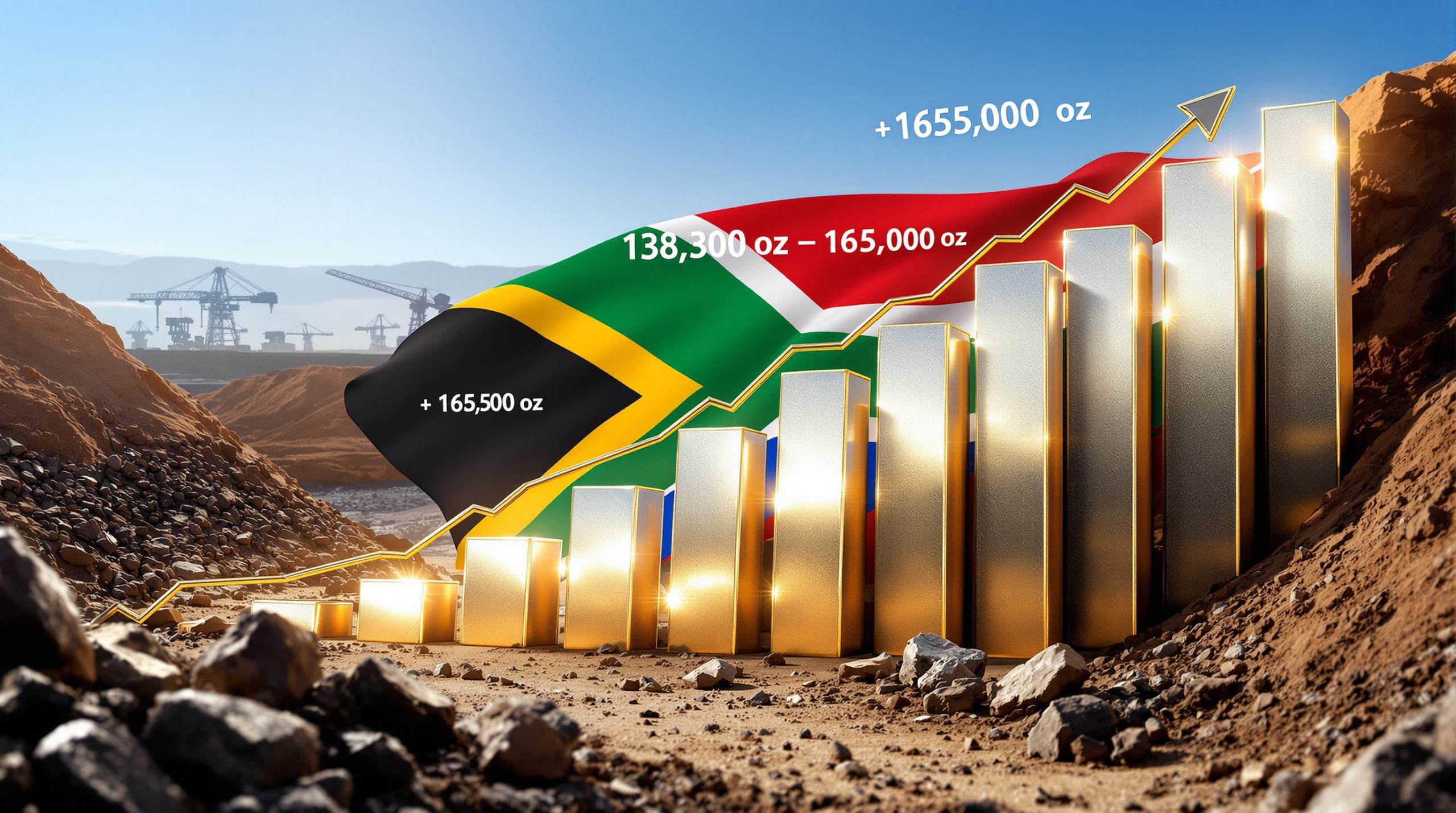China's Rare Earth Export Decline: Market Trends and Global Impact
China's rare earth exports experienced a notable shift in August 2025, with shipments decreasing by 3.4% month-on-month to 5,792 metric tons, down from July's 5,994 tons. Despite this monthly dip, these figures represent a substantial year-on-year increase of 22.6% compared to August 2024's 4,723 tons. Looking at the broader picture, the first eight months of 2025 have seen cumulative exports reach 44,355 tons, marking a significant 14.5% increase over the same period in 2024, according to data from China's General Administration of Customs.
These fluctuations highlight the dynamic nature of China's rare earth market, which continues to play a pivotal role in global supply chains for these critical minerals—a group of 17 elements essential for manufacturing high-tech products ranging from electric vehicles to defense systems.
Recent Export Volume Fluctuations and Market Implications
The monthly variations in China's rare earth export volumes can be attributed to several factors affecting both supply and demand sides of the market. The August decline follows a strong performance in July, suggesting potential seasonal adjustments rather than a fundamental shift in export policy or capacity.
Key export statistics from recent months include:
- August 2025: 5,792 metric tons (3.4% decrease from July)
- July 2025: 5,994 metric tons
- August 2024: 4,723 metric tons (22.6% year-on-year increase)
- January-August 2025: 44,355 tons (14.5% increase year-on-year)
Several factors are likely contributing to these monthly variations:
- Seasonal industrial demand cycles, particularly in manufacturing sectors
- Inventory management strategies by major buyers
- Production adjustments in response to domestic demand fluctuations
- Logistics and shipping schedule variations
Industry analysts note that while monthly fluctuations provide insight into short-term trends, the substantial year-on-year growth suggests robust overall demand for these critical materials despite global economic uncertainties and ongoing US‑China trade tensions.
China's Strategic Export Controls on Rare Earth Elements
China's approach to rare earth exports has evolved significantly in recent years, reflecting the strategic importance of these materials. While specific details about regulatory changes implemented in 2025 require further verification, China has historically used various policy tools to manage its rare earth exports.
Strategic Resource Management Approach
China's rare earth industry operates under a comprehensive management framework that typically includes:
- Consolidation of mining operations under larger state-influenced enterprises
- Environmental compliance requirements for mining and processing
- Production quotas to manage resource sustainability
- Export licensing mechanisms for certain high-value materials
The rare earth export sector represents a significant leverage point in international trade relations, particularly as demand for these materials continues to grow in critical minerals energy transition sectors like renewable energy and electric vehicles.
Rare Earth Magnet Export Performance
One bright spot in China's rare earth export picture has been the performance of rare earth magnets—a value-added product category with applications across multiple high-tech industries. According to customs data, rare earth magnet exports hit a six-month high in July 2025, demonstrating resilience in this critical segment of the market.
This recovery in magnet exports is particularly significant as permanent magnets, especially neodymium-iron-boron (NdFeB) varieties, represent one of the highest-value applications for rare earth elements. These magnets are essential components in:
- Electric vehicle motors
- Wind turbine generators
- Industrial automation equipment
- Consumer electronics
- Medical devices
The strong performance in magnet exports suggests that downstream manufacturing demand remains robust despite broader economic uncertainties, and that Chinese producers continue to maintain their competitive advantage in this value-added segment.
China's Position in the Global Rare Earth Market
China maintains its position as the world's largest producer and exporter of rare earth minerals, with a dominant role in both mining and processing stages of the supply chain. This market leadership position has been built over decades through strategic investments in extraction, processing technology, and downstream manufacturing capabilities.
Key Elements of China's Rare Earth Industry
China's rare earth industry encompasses the full value chain from mining to finished components:
- Primary mining operations concentrated in Inner Mongolia and southern provinces
- Extensive processing capacity for separating individual rare earth elements
- Advanced manufacturing capabilities for high-value applications like magnets
- Research and development infrastructure for new applications and technologies
This integrated approach has allowed China to maintain a significant competitive advantage in the global rare earth market, even as other countries seek to develop alternative supply sources through rare earth upgrade insights and technological advancements.
Global Market Responses to China's Export Patterns
The fluctuations in China's rare earth exports have significant implications for global markets and supply chains dependent on these materials. Monthly variations can impact pricing, availability, and strategic planning for manufacturers worldwide.
Alternative Supply Chain Development
In response to China's dominant market position, various countries and companies have accelerated efforts to develop alternative supply sources:
- Australia has positioned itself as a key alternative supplier, with several major mining operations and Australia's critical minerals reserve
- United States has designated rare earths as critical minerals with national security implications
- European Union has established a Critical Raw Materials Act to reduce dependency on foreign suppliers
- Japan has invested heavily in recycling technologies and strategic partnerships with non-Chinese suppliers
Despite these efforts, China's processing capacity and technical expertise in rare earth separation remain unmatched, creating continued dependencies even when raw materials are sourced elsewhere.
Geopolitical Implications of China's Rare Earth Trade Policies
The strategic importance of rare earth elements extends well beyond their commercial value, making them increasingly significant in international relations and trade negotiations. As essential components in defense technologies, renewable energy systems, and high-tech manufacturing, rare earths have become focal points in discussions about supply chain security and technological sovereignty.
Strategic Resource Competition
Major economies increasingly view rare earth supply security as a matter of national interest:
- National security concerns have prompted investment in domestic supply chains
- Trade negotiations increasingly include provisions related to critical mineral access
- International partnerships are forming around securing diverse supply sources
- Government support programs for rare earth mining and processing are expanding
These geopolitical dimensions add complexity to market dynamics, as purely commercial considerations are often supplemented by strategic national interests.
Future Outlook for China's Rare Earth Export Trends
Based on current trends and market conditions, several potential scenarios emerge for China's rare earth export patterns in the coming months and years.
Short-Term Outlook (6-12 Months)
In the near term, China's rare earth exports are likely to continue showing moderate growth with month-to-month fluctuations. Several factors will influence this trajectory:
- Continued strong demand from electric vehicle manufacturing
- Seasonal production and shipping patterns
- Potential adjustments to export policies or quotas
- Global economic conditions affecting manufacturing activity
Monthly variations like August's 3.4% decline represent normal market fluctuations rather than fundamental shifts in China's export strategy or capacity.
Medium-Term Considerations (1-3 Years)
Looking further ahead, China's approach to rare earth exports will likely balance several strategic objectives:
- Maintaining domestic supply security for strategic industries
- Maximizing value creation through exports of processed materials rather than raw ores
- Responding to international pressure regarding market access
- Balancing environmental considerations with economic benefits
This balancing act will likely result in a managed growth approach rather than dramatic increases or decreases in export volumes.
Industries Most Affected by Rare Earth Supply Changes
Several high-tech and green energy sectors are particularly sensitive to changes in rare earth availability and pricing due to their dependence on these materials for critical components.
Key Dependent Sectors
Industries with significant exposure to rare earth supply fluctuations include:
- Electric Vehicle Manufacturing: Rare earth permanent magnets are essential for high-efficiency motors
- Wind Energy: Large permanent magnets enable direct-drive wind turbine designs
- Consumer Electronics: Speakers, vibration motors, and display technologies rely on rare earth materials
- Defense Systems: Guidance systems, radar technology, and communications equipment use rare earth components
- Medical Imaging: MRI machines and other diagnostic equipment utilize rare earth magnets
For these industries, even minor disruptions in rare earth supply chains can have significant impacts on production capabilities and costs.
Adaptation Strategies
Companies in these sectors are implementing various strategies to manage rare earth supply risks:
- Developing designs that use reduced quantities of critical rare earth elements
- Establishing recycling programs to recover materials from end-of-life products
- Diversifying supplier relationships to reduce dependency on single sources
- Researching alternative materials with similar properties
These approaches help build resilience against potential supply disruptions while managing cost volatility.
Rare Earth Trade and Global Sustainability Goals
The rare earth supply chain presents both challenges and opportunities in the context of global sustainability objectives. While these materials are essential for many green technologies, their extraction and processing raise significant environmental concerns.
Environmental Considerations
Rare earth mining and processing involve several environmental challenges:
- Energy-intensive separation and purification processes
- Potential for radioactive waste from certain rare earth deposits
- Land disturbance and habitat impacts from mining operations
- Water usage and potential contamination concerns
These environmental factors create a complex sustainability equation, as rare earth materials enable renewable energy technologies while potentially creating environmental impacts during production. This paradox has led to increased focus on mining sustainability trends across the industry.
Balancing Priorities
The global rare earth industry faces the challenge of balancing:
- Growing material needs for clean energy technologies
- Environmental impacts of extraction and processing
- Economic development opportunities in producing regions
- Supply security concerns for importing nations
Finding sustainable approaches to rare earth production and use remains a critical challenge for the industry and policymakers alike, as noted in recent economic analyses of the sector.
FAQ: Understanding China's Rare Earth Export Trends
Why are rare earth elements so important to modern technology?
Rare earth elements possess unique physical and chemical properties that make them irreplaceable in many high-tech applications. Their magnetic, luminescent, and electrochemical characteristics enable smaller, lighter, and more efficient components in everything from smartphones to electric vehicles. Despite their name, most rare earths are relatively abundant in the Earth's crust, but they're rarely found in concentrated, economically viable deposits.
How might fluctuations in China's exports affect global supply chains?
Monthly variations in export volumes can create short-term price volatility and supply uncertainty for manufacturers. However, the more significant concern for global supply chains is potential structural changes to China's export policies or quotas, which could have lasting impacts on availability and pricing. Companies with high dependency on rare earth materials typically maintain inventory buffers and diversified supplier relationships to mitigate these risks.
What alternatives exist to Chinese rare earth supplies?
Several alternative sources of rare earth materials have emerged or expanded in recent years:
- Australia has significant production capacity through operations like Lynas Rare Earths
- The United States has reactivated domestic mining and processing capabilities
- Canada, Vietnam, and Brazil have developing rare earth projects
- Recycling programs are recovering increasing volumes from end-of-life products
However, China's dominance in processing technology means that even materials mined elsewhere often return to China for separation and refinement, creating continued interdependencies.
How are automotive manufacturers responding to rare earth supply concerns?
The automotive industry, particularly electric vehicle manufacturers, has implemented multiple strategies to address rare earth supply risks:
- Designing motors that use reduced quantities of heavy rare earth elements
- Investing in recycling infrastructure to recover materials from end-of-life vehicles
- Forming strategic partnerships with mining companies to secure supply
- Researching alternative motor designs that reduce or eliminate rare earth dependency
These approaches help build resilience against potential supply disruptions while managing material costs.
What role does recycling play in rare earth supply chains?
Recycling represents a growing but still limited portion of the rare earth supply chain. Technical challenges in recovering these materials from complex products have historically limited recycling rates, but improving technologies and economic incentives are gradually increasing recovery volumes. The most promising recycling opportunities involve industrial magnets, where the concentrated and relatively pure rare earth content makes recovery more economical than from more dispersed consumer products.
The Path Forward
As China's rare earth export patterns continue to evolve, both producing and consuming nations face the challenge of developing sustainable, secure, and environmentally responsible supply chains for these critical materials. The August 2025 export data represents just one data point in this complex landscape, but the broader trends suggest continued growth in both production and demand for these essential elements of the modern technological economy.
For industries dependent on rare earth materials, developing supply chain resilience, exploring material alternatives, and engaging in proactive management of potential disruptions will remain key priorities in navigating this dynamic market environment.
Wondering If You'll Miss the Next Major Mining Discovery?
Discover why major mineral discoveries can lead to significant market returns by exploring Discovery Alert's dedicated discoveries page, showcasing how their proprietary Discovery IQ model delivers real-time alerts on significant ASX mineral discoveries, instantly turning complex data into actionable investment insights.




